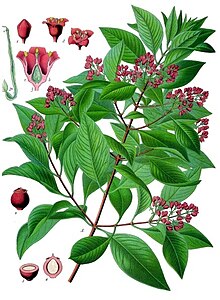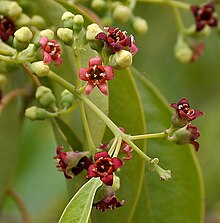
Sandalwood is a class of woods from trees in the genus Santalum. The woods are heavy, yellow, and fine-grained, and, unlike many other aromatic woods, they retain their fragrance for decades. Sandalwood oil is extracted from the woods. Sandalwood is often cited as one of the most expensive woods in the world. Both the wood and the oil produce a distinctive fragrance that has been highly valued for centuries. Consequently, some species of these slow-growing trees have suffered over-harvesting in the past.

Santalum is a genus of woody flowering plants in the Santalaceae family, the best known and commercially valuable of which is the Indian sandalwood tree, S. album. Members of the genus are trees or shrubs. Most are root parasites which photosynthesize their own food, but tap the roots of other species for water and inorganic nutrients. Several species, most notably S. album, produce highly aromatic wood, used for scents and perfumes and for herbal medicine. About 25 known species range across the Indomalayan, Australasian, and Oceanian realms, from India through Malesia to the Pacific Islands, as far as Hawaiʻi and the Juan Fernández Islands off the coast of South America.

Agarwood, aloeswood, eaglewood, gharuwood or the Wood of Gods, most commonly referred to as oud or oudh, is a fragrant, dark and resinous wood used in incense, perfume, and small hand carvings. It forms in the heartwood of Aquilaria trees after they become infected with a type of Phaeoacremonium mold, P. parasitica. The tree defensively secretes a resin to combat the fungal infestation. Prior to becoming infected, the heartwood mostly lacks scent, and is relatively light and pale in colouration. However, as the infection advances and the tree produces its fragrant resin as a final option of defense, the heartwood becomes very dense, dark, and saturated with resin. This product is harvested, and most famously referred to in cosmetics under the scent names of oud, oodh or aguru; however, it is also called aloes, agar, as well as gaharu or jinko. With thousands of years of known use, and valued across Muslim, Christian, and Hindu communities, oud is prized in Middle Eastern and South Asian cultures for its distinctive fragrance, utilized in colognes, incense and perfumes.

Santalum acuminatum, the desert quandong, is a hemiparasitic plant in the sandalwood family, Santalaceae, which is widely dispersed throughout the central deserts and southern areas of Australia. The species, especially its edible fruit, is also commonly referred to as quandong or native peach. The use of the fruit as an exotic flavouring, one of the best known bush tucker, has led to the attempted domestication of the species.

Acacia acuminata, commonly known as raspberry jam, jam or jam tree is a species of flowering plant in the family Fabaceae and is endemic to the south-west of Western Australia. it is a tree with linear to narrowly elliptic phyllodes, spikes of golden-yellow flowers and papery to leathery pods.

Santalum spicatum, the Australian sandalwood, also Waang and other names (Noongar) and Dutjahn (Martu), is a tree native to semi-arid areas at the edge of Southwest Australia, in the state of Western Australia. It is also found in South Australia, where it is protected and listed as a vulnerable species. It is traded as sandalwood, and its sandalwood oil has been used as an aromatic and a food source over history. S. spicatum is one of four Santalum species occurring in Australia.
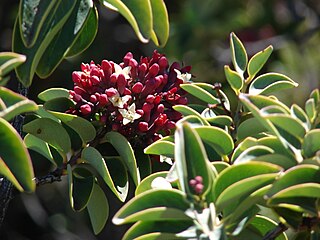
Santalum haleakalae, known as Haleakala sandalwood or ʻIliahi in Hawaiian, is a species of flowering tree in the sandalwood family, that is endemic to the islands of Maui, Lanai, and Molokai in the Hawaiian Islands, part of the United States. It grows in subalpine shrublands at elevations of 1,900 to 2,700 m, especially on the slopes of Haleakalā.

α-Santalol, also referred to as alpha-santalol, is an organic compound that is classified as a sesquiterpene. It comprises about 55% of the oil of sandalwood, another less abundant component being β-santalol. As of 2002, about 60 tons of sandalwood oil are produced annually by steam distillation of the heartwood of Santalum album. It is a valued component for perfumes.
Sandalwood is the common name of many species of plants and their wood and oils.

Sandalwood oil is an essential oil obtained from the steam distillation of chips and billets cut from the heartwood of various species of sandalwood trees, mainly Santalum album and Santalum spicatum.

Santalum freycinetianum, the forest sandalwood, Freycinet sandalwood, or ʻIliahi, is a species of flowering tree in the European mistletoe family, Santalaceae, that is endemic to the Hawaiian Islands. Its binomial name commemorates Henri Louis Claude de Saulces de Freycinet, a 19th-century French explorer. ʻIliahi inhabits dry, coastal mesic, mixed mesic, and wet forests on Oʻahu, Kauaʻi, Lānaʻi, Maui, and Molokaʻi at elevations of 250–950 m (820–3,120 ft). It grows in areas that receive 500–3,800 mm (20–150 in) of annual rainfall. Like other members of its genus, ʻiliahi is a root hemi-parasite, deriving some of its nutrients from the host plant; common hosts include koa, koaiʻa, and ʻaʻaliʻi.

Santalum ellipticum, commonly known as ʻIliahialoʻe (Hawaiian) or coastal sandalwood, is a species of flowering plant in the mistletoe family, Santalaceae, that is endemic to the Hawaiian Islands. It is a sprawling shrub to small tree, typically reaching a height of 1–5 m (3.3–16.4 ft) and a canopy spread of 1–3 m (3.3–9.8 ft), but is extremely variable in size and shape. Like other members of the genus, S. ellipticum is a hemi-parasite, deriving some of its nutrients from the host plant by attaching to its roots.

Cassia abbreviata, commonly known as the sjambok pod or long-tail cassia, is a mostly tropical tree species in the genus Cassia, which is native to Africa.

Osyris compressa is a facultatively hemiparasitic, mainly South African plant of the sandalwood family, Santalaceae. Until recently, the favoured binomial name was Colpoon compressum, but around 2001, the genus Colpoon was included in Osyris on the basis of comparative DNA studies. That assignment is not final, however, and according to the Kew Gardens plant list, Colpoon compressum P.J.Bergius, though still in review, is the accepted name.
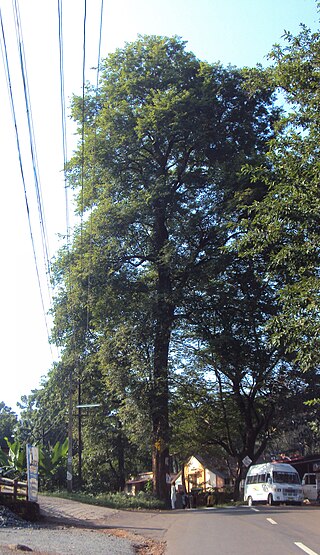
Dalbergia latifolia is a premier timber species, also known as the Indian rosewood. It is native to low-elevation tropical monsoon forests of south east India. Some common names in English include rosewood, Bombay blackwood, roseta rosewood, East Indian rosewood, reddish-brown rosewood, Indian palisandre, and Java palisandre. Its Indian common names are beete, and satisal. The tree grows to 40 metres (130 ft) in height and is evergreen, but locally deciduous in drier subpopulations.
Sesbania rostrata is a small semi-aquatic leguminous tree, in the genus Sesbania. It forms a symbiotic relationship with Gram-negative rhizobia which leads to the formation of nitrogen fixing nodules on both stem and roots. It is mainly used as green manure to improve soil fertility due to its fast growth, high biomass production and ability to convert large amounts of atmospheric nitrogen into a usable form for plants. Other applications include production of high quality forage for livestock and it is a source of fuel-wood.
Osyris daruma is a species of plant in the family Santalaceae.

Mysore Sandalwood Oil is a trademarked perfume oil extracted from the Santalum album variety of sandalwood tree in the Mysore district of Karnataka, India. The tree species is said to be one of the best varieties in the world.
Ximenynic acid is trans-11-octadecen-9-ynoic acid, a long-chain acetylenic fatty acid.
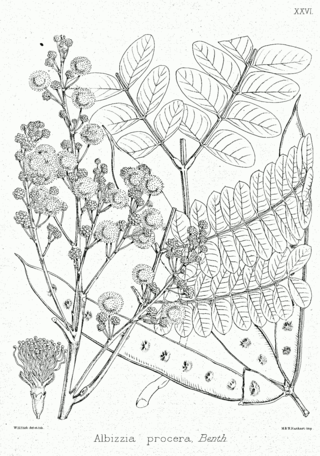
Albizia procera, commonly known as white siris or karoi tree, is a species of large tree found natively in southeast Asia and India. It is most commonly found in open forests, but may also be found on the margins of rain forests and in monsoon and gallery forests. It is considered an invasive species in South Africa.
